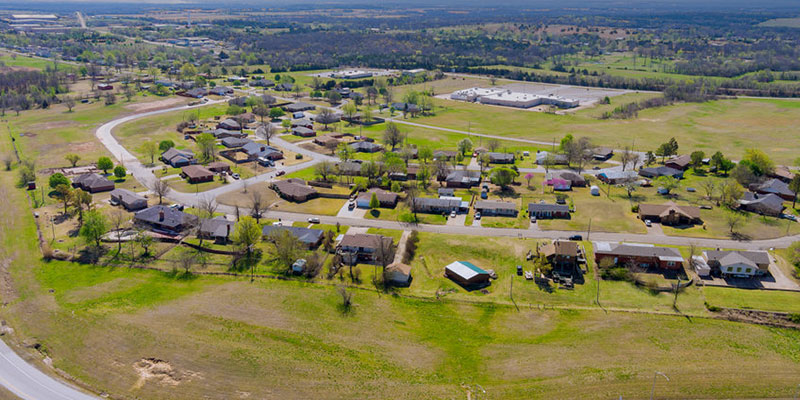Small, rural communities often face challenges when it comes to water and wastewater treatment, but an up-to-date decentralized strategy may be available at no upfront cost.
With Fluence equipment and financing solutions, rural areas may update services at no upfront cost
Many rural water utilities are coping with aging or inadequate water and wastewater treatment systems. At the same time, they’re searching for ways to extend wastewater services to outlying areas, and to meet the challenges of treating water for microbes, insecticides, radioactive substances, and nutrients from agricultural runoff and leaky septic systems.
Even if smaller communities lack the financial resources for upgrades, or the construction, operation, and maintenance of up-to-date infrastructure, a number of innovative solutions are now available to solve their problems.
Decentralized Solutions Overcome Distance, Climate, and Terrain Challenges
Decentralized systems, which include individual or cluster septic systems, as well as advanced treatment systems, already shoulder much of the wastewater treatment load in rural areas, and it’s no mystery why.
Distance, climate, and difficult terrain can make it difficult, or impossible, to connect with centralized treatment plants. Treating wastewater where it’s generated also eliminates the need for long pipelines. Typically, 75% of wastewater treatment plant CAPEX goes to pipelines, which also carry a high OPEX due to maintenance and the energy needed for pumping. Generally, the less pipe the better.
While rural areas are no stranger to decentralized treatment, technological advances have been earning their stripes as they make high-quality decentralized treatment a reality.
Take for example the membrane aerated biofilm reactor (MABR) technology found in Fluence Aspiral™ wastewater treatment plants. MABR plants use simultaneous nitrification-denitrification to produce water that exceeds the toughest water reuse standards in the world, including California’s Title 22.
When wastewater is treated to nonpotable reuse standards where it’s generated, the local community can benefit from a safe, beneficial second use of its own water for agricultural irrigation and other applications.
Upgrading Centralized Treatment
While rural wastewater treatment often utilizes decentralized wastewater treatment, some rural communities are serviced by smaller central treatment plants. In that case, they may be more focused on upgrading their existing plant to increase nutrient removal, lower energy use, and/or increase capacity.
Instead of expanding the plant with new construction, utilities can use MABR technology to upgrade the plant without additional footprint and maintenance costs.
For example, Fluence’s SUBRE is a system that uses towers of MABR modules that are submerged in an existing aeration chamber. By eliminating high-pressure aeration, MABR slashes energy use. The globally validated technology also increases capacity and nutrient removal — without increasing the physical footprint — and can be installed in only a few days.
Desalination of Brackish Water
For drinking water purification, NIROBOX™ modular units offer energy-efficient reverse osmosis (RO) technology in containerized packaging. Units are manufactured for specific source waters, using a customized train of filtration, disinfection, and polishing stages to purify virtually any source water — including brackish groundwater — to drinking water standards.
Fluence’s treatment units are manufactured inside standard steel shipping containers for easy delivery and installation anywhere a shipping container can go. The weatherized containers, rated for 150 mph wind resistance, make up the plants’ permanent housing, so minimal construction is needed. What’s more, the units are designed for remote monitoring and operation by nonspecialized personnel.
VOCs and Radiological Contaminants
Sometimes drinking water is contaminated by volatile organic compounds (VOCs) or radiological compounds. For instance, radon, a radioactive gas created by the decay of radium, can be found naturally in groundwater. In some parts of the U.S., radon has been detected at elevated levels, including across Connecticut, where homeowners have been encouraged to have their water tested as recently as 2021.
Fluence’s compact Breeze® air stripper addresses VOCs and radiological contaminants prevalent in some regions. The highly efficient technology can economically remove nearly 100% of VOCs and other gases dissolved in water.
Financing Water Treatment Infrastructure Upgrades
Rural water utilities have the option of entering into public-private partnership (PPP) models such as build-own-operate (BOO) or build-own-operate-transfer (BOOT) financing structures. These allow rural water utilities to quickly put up-to-date infrastructure in place with no initial investment and virtually no risk to public assets. Under PPP structures, a private company finances, constructs, owns, and operates infrastructure for an extended term. A private company handles the water system, and the service area pays for only the water or sanitation service.
Fluence’s Water Management Services offer a suite of full water cycle solutions under BOO and BOOT financing models. With these solutions, small water authorities are no longer hampered by the limited managerial capacity and the need to attract, train, and retain skilled operators. There’s no longer a need to wait for financing or to navigate a complex consolidation process. Contact our experts to discuss the needs of your rural service area

